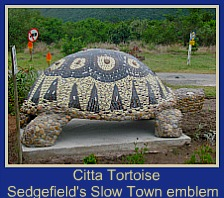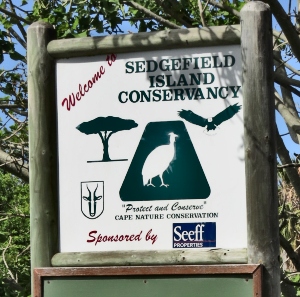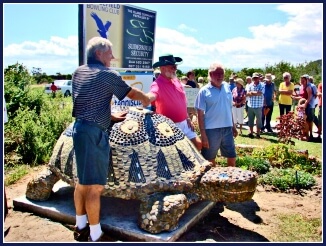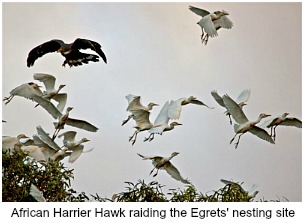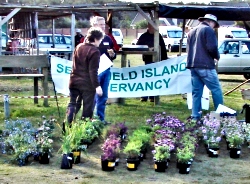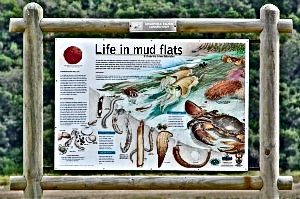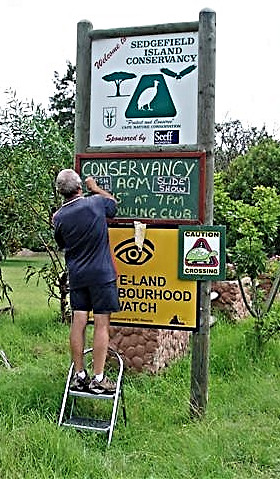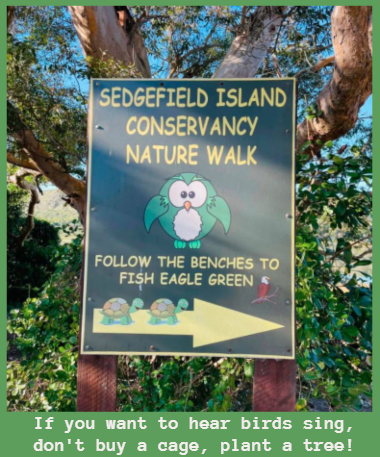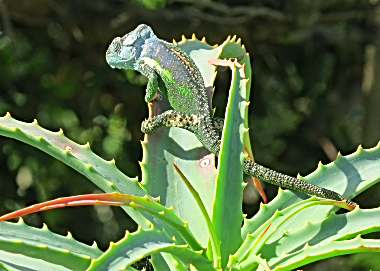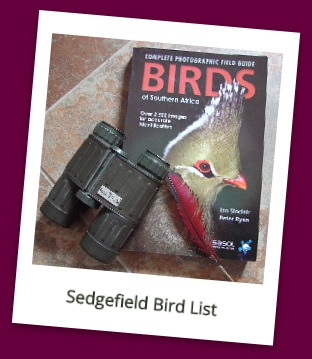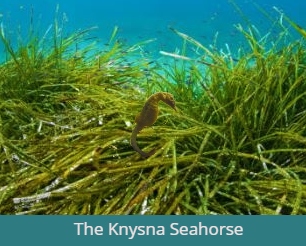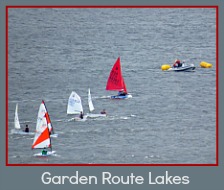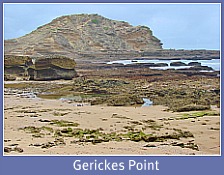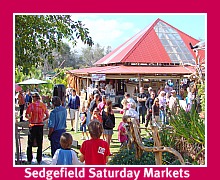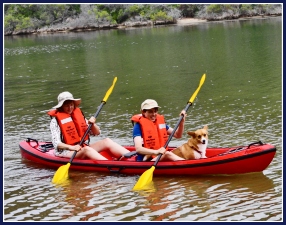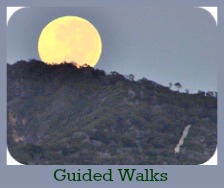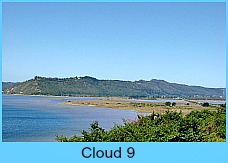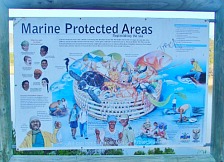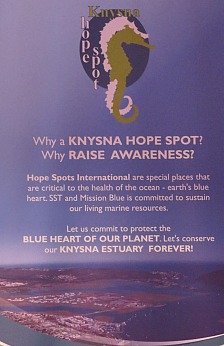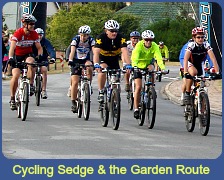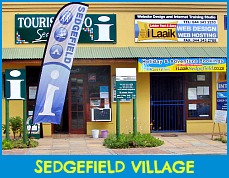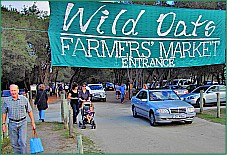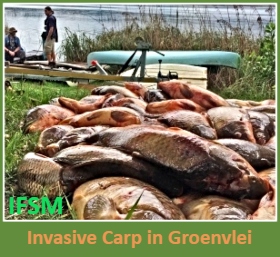Sedgefield Island Conservancy
Caring for Nature in Suburbia
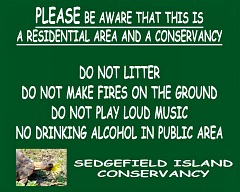
The Sedgefield Island Conservancy is a special group of individuals that the Sedgefield community is fortunate to have rooting for the environment! Begun in 2003 with founder members Di Young and Jean Wright, the conservancy is now nearly 9 years old and has grown from strength to strength. Nine people make up the current committee.
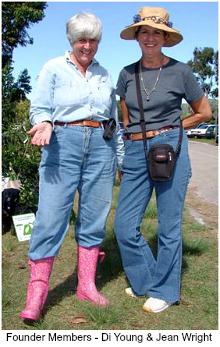
Their job requires ongoing commitment and physical hard work. Although they have a support group of +/- 260 members, it is mostly the committee members that get stuck in and do the manual labour with assistance offered by others occasionally. (not that this dampens their enthusiasm!)
Collectively it is the aim of this active group of caring conservationists to counteract and minimise the negative effects that many human actions have on the natural surrounds of the Island. After all it's the Garden Route’s magnificent outdoors that draws so many people to it.
Addressing the Island Conservancy, retired geologist, Mr Tony Cain said of the area,
“You have the unique, total and remarkable continuous geographical history of the last 2 million years right here on your doorstep - mountains, lakes, rivers, dunes, and estuaries all intact and together…… We are sitting on a major historical heritage site and it should be sacrosanct. It should be guarded jealously”
Contact Numbers for the Sedgefield Island Conservancy Committee
Lawrence Boatwright
Helia Van Zyl
Linda Boatwright
Susan Le Roux
Beryl Stiles
Mary Hunter
Trevor Mynhardt
Tommy Willich
Co-Chair
Co-Chair
Treasurer
Secretary
Articles and Publications
iNaturalist/Archives
Engineer
Projects and Maintenance
083 376 7846
082 332 2206
083 564 6539
073 784 3317
073 155 0859
082 900 8680
082 963 4558
072 740 4842
The Sedgefield Island Conservancy Activities
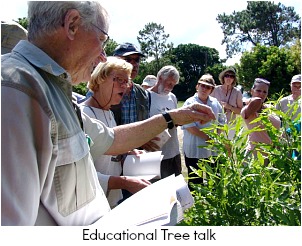 Follow the Benches Island Walk
Follow the Benches Island WalkSo as Tony Hunter wrote in our local newspaper on 4 June 2008, they did 3 things when the Sedgefield Island Conservancy was first formed in 2003 – read the Cape Nature Guidelines carefully - stole ideas from other conservancies – created a Management Plan to build a foundation for the conservancy to facilitate continuity when the time came for one committee to hand over to another.
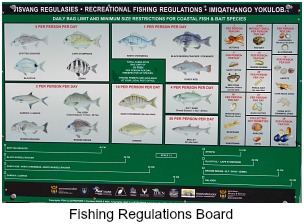
The business-like intentions of the plan to conserve, participate, co-operate, educate, etc. translates into demanding day to day activities such as:
- Affiliations -Try to attend all meetings and forums of related and like-minded bodies to create alliances in order to learn from or give help to, such as Cape Nature, SANParks, Knysna Municipality, Eden to Addo Project, Garden Route Initiative, the Outeniqua Forum, the Water Forum, Botanical Society of South Africa, WESSA and Sedgefield Ratepayers Association. (and.... still have a life!)
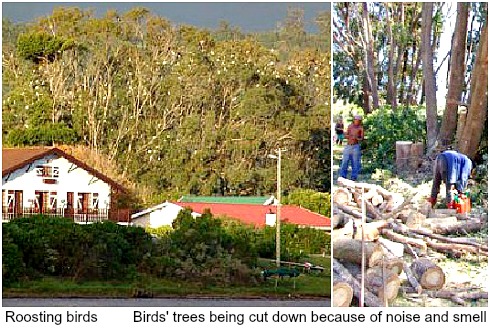
- Conservation Efforts
1.Chase guinea fowl with gut on legs for 2 weeks, resort to trap, succeed.
2. Lose Conservancy members for protecting nesting birds.
3. Propose creation of island refuges in the Swartvlei for roosting and breeding waterbirds to free them from human interference. Get told by conservation authorities you are being silly.
4. Layout new indigenous garden, have compost stolen before completion.
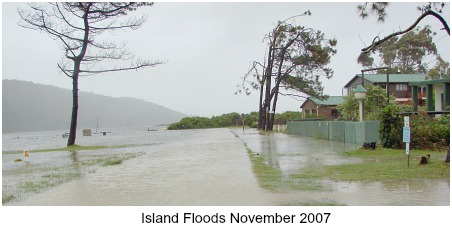
- Try to work with Developers
1. Meet and get bamboozled by all the benefits and jobs coming your way.
2. Get dirty looks for asking awkward questions.
- Work Parties
1. Remove builders’ rubble or swimming pool filter sand from Enviro-gardens.
2. Remove alien vegetation only to find it’s back next week.
3. Create “example gardens” – waterwise being one of them – then wait 2 weeks for
floods to subside to see if plants have survived.
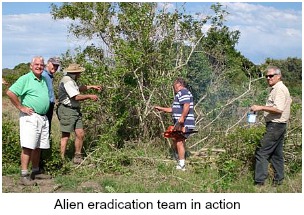
- Other
4. Erect “Fishing Code of Conduct” signs, try to remove graffiti one week later.
5. Get a “degree” in effective use of herbicides.
6. Erect bird perches in difficult position, capsize canoe and nearly drown.
7. Request map of underground pipes/cables to facilitate tree planting and discover such a document does not exist.
8. Meet with geologist to understand geology of area for management plan. Don’t understand. Learn new words like “Holocene era”!
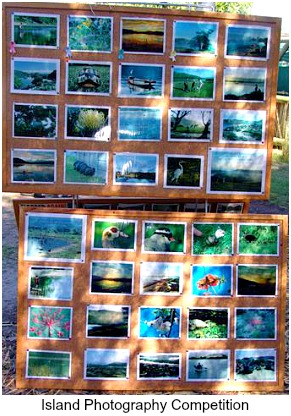
- Create Awareness
1. Spend weekend putting up tortoise crossing signs then removed squashed tortoise from road.
2. Be friendly to local newspapers to ensure you get your conservation articles published.
3. Put up signs to ‘brag” about work done. Have sign ridden over by car.
- Fund Raising
1. Create postcards to sell at profit. Destroy one’s printer in the process.
2. Hold annual plant sale. Get sunstroke.
3. Hold a photographic competition of the area. Expect 5 entries. Spend 2 weeks trying to judge 120 stunning entries.

Some Sedgefield Island Conservancy Successes
- Cleaned up the alien vegetation on the Island side of the Perdespruit.
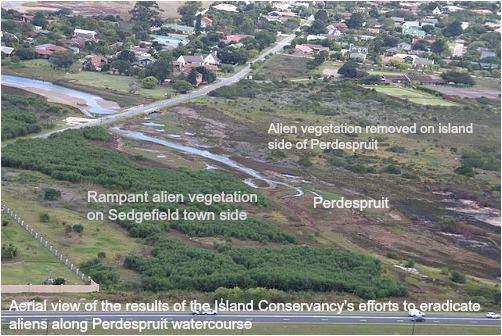
- Have considerable success in encouraging homeowners to remove Class 1 and other aliens on their properties and replace them with indigenous shrubs/trees.
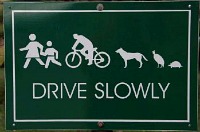
- Printed tortoise t-shirts, bumper stickers, licence disc holders and “warning” road signage to make people aware of their SLOW but valued presence round and about Sedgefield and particularly, on the Island.
- Signage to remind people that the Island is a residential suburb and to watch out for people, bicycles, dogs and birds like (guinea-fowl and dikkops)as well.
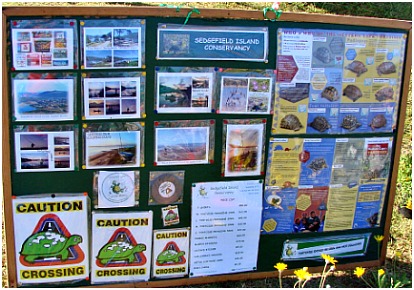
- Formed a Tree Committee that includes Members of the Ratepayers and the Municipality. – no trees can be cut down on verges without their permission.
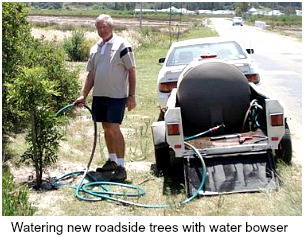
- Built a Bowser to water the young indigenous trees that they or the municipality have planted in public areas.
- Have created lists of Island Plants and Birds.
- Have planted various Sample Gardens on verges
a)Top of Van Riebeck along the side of Island Village
b) On Fish Eagle Green
c) Corner of Dr Malan, Lorraine and Van Niekerk streets.
Members regularly water and weed these gardens.
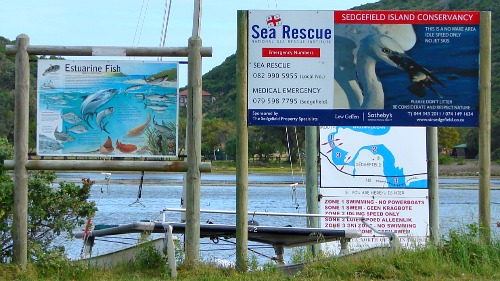
- Awareness signage – Boards of Estuaries and Estuarine Birds, Tortoises and Fishing Codes of Conduct.
- Maintenance of the Enviro-gardens established by WESSA that provide sanctuary for island wildlife and birds.
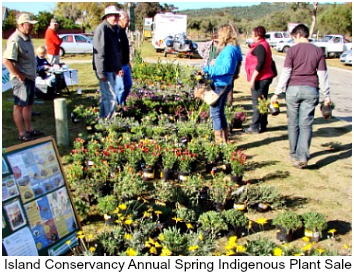
- A holiday pack placed in timeshare units for Island visitors. It includes information about the conservancy, tortoises, Fishing Code of Conduct and an Island Bird List.
- Hold a popular annual indigenous plant sale to create awareness and raise funds for projects.
- Port-a-loos are arranged at Eagle Green for the holiday season so people don’t use the bush.
- Created
their own website
https://www.sedgefieldislandconservancy.co.za/
The Perdespruit Bird Island Project
This wonderful project initiated by the Island Conservancy has been made possible because Cliff Elion, owner of a large part of the Perdespruit wetland, had already cleared a huge area of its alien vegetation and whole-heartedly agreed to having bird islands built in the wetland for roosting and nesting purposes. Besides nesting colonial birds like egrets, cormorants, herons and spoonbills many other birds will use them for resting and hawking insects from and kingfishers to dive from their perch to catch their prey.
Formerly, colonial birds had nested in tall mature trees along streets on the Island. These eventually were cut down due to the stench of the birds' accumulative pungent excretions and the inevitable deaths of many baby birds. This was very unpleasant for anyone living in the vicinity of the trees and also resulted in many of the trees dying.
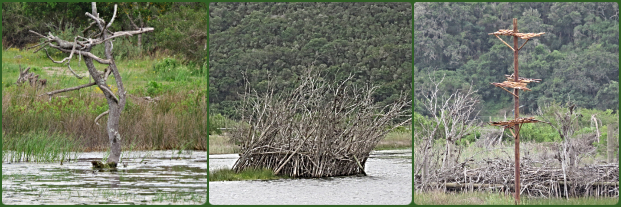 Perch, Roost and Nesting Platforms for water-based birds.
Perch, Roost and Nesting Platforms for water-based birds.SANParks gave their support to the project as did Knysna Municipality and, Cape Nature. This allowed the Island Conservancy handyman, Daniel Metter, with assistance from SANParks, to assemble two natural branch based islands in the Perdespruit each within a sturdy wooden frame and separately, a tall pole with three spaced nesting platforms, just ahead of the breeding season.
The conservation world can be political, emotional, confusing, disappointing and very, very frustrating. An Urban Conservancy brings with it a lot of added problems and challenges. Fortunately, all the folks on the Sedgefield Island Conservancy committee remain dedicated to the Island’s conservation ethic and accept the challenges they face believing they are making a difference.
Sedgefield Island Conservancy Info for new Residents
Coming from the urban jungle where wildlife is the last thing on people’s minds, would-be residents are oblivious of the fact, as they clear their stands down to bare earth in preparation for building their homes, that they have, in the process, utterly obliterated the habitat of many wild creatures that had been living there up to that point.
It would help no end if among all the Municipality’s restrictions and guidelines they impose on new building sites, (we know from first hand experience) they could include something about asking new residents to consider retaining a small portion of indigenous bush on their properties for bird and animal life.
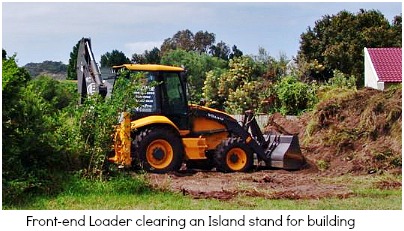
Local builders could play their part by advising newcomers to call in the “tortoise squad” (see contacts below) to remove tortoises before the bulldozer moves in to rip out and flatten everything.
The Sedgefield Island Conservancy would be happy to remove indigenous bulbs and plants to enviro-gardens that would otherwise be stifled forever under concrete foundations.
Fynbos is one of the most unique and threatened biomes on the planet and few suburban areas have the privilege of experiencing tortoises, dikkops and guinea-fowl living amongst them. Sadly, many of us find out in retrospect and only after living here for a while, the devastating and unnecessarily destructive effects of our ignorance.
Another issue arising on the Island more frequently than it used to, is the increasing numbers of dogs running free whether accompanied by their owners or when they escape onto the streets alone.
 Dogs on the loose.
Dogs on the loose.Birdlife is being regularly harassed by domestic dogs and in some instances with fatal results, for the birds or their chicks.
Worldwide statistics show 49 bird species are in decline and 1 in eight species are in threat of extinction.
Be mindful, people, it is a conservation area and you are privileged to live in it! Eager Estate Agents should, at the very least, warn their clients of the Island's status too! If you can't keep your dogs in your yard, make a secure place within your yard to keep them there when you cannot monitor them yourself. Our wild life in suburbia is what makes Sedgefield special for most of us and the Island in particular, has been a place where much of our birdlife and tortoises have continued to thrive because of that more protected environment while Sedgefield itself has lost much of that charm.
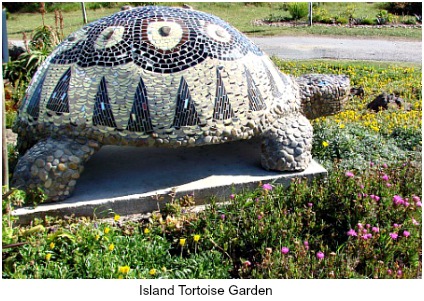
The mosaic tortoises that greet one at both entrances to the Island should remind us that the tortoise is an integral part of the Island environment treasured by most of its inhabitants and drivers are asked to please give way to tortoises wherever they chance to come across them.
As a village, we should be exceedingly grateful for the priceless contribution the Sedgefield Island Conservancy makes in preserving and maintaining nature’s presence on the Island.
It all adds up to keeping Sedgefield the ‘Outdoor” home and holiday place so many people appreciate.
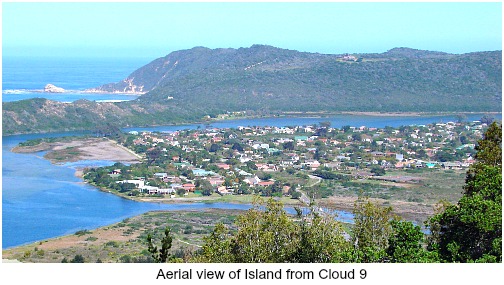

Links to Related Sites


The Green Times is SA's bi-weekly green newspaper! If you are concerned and excited about the greening of our society, then this is your news portal. Use our green calendar to know what's happening - attend, be informed and spread this crucial education wherever you go. Subscribe and consistently learn how to green up all aspects of your life and work, so you can help lead our society transitioning towards a sustainable future.

